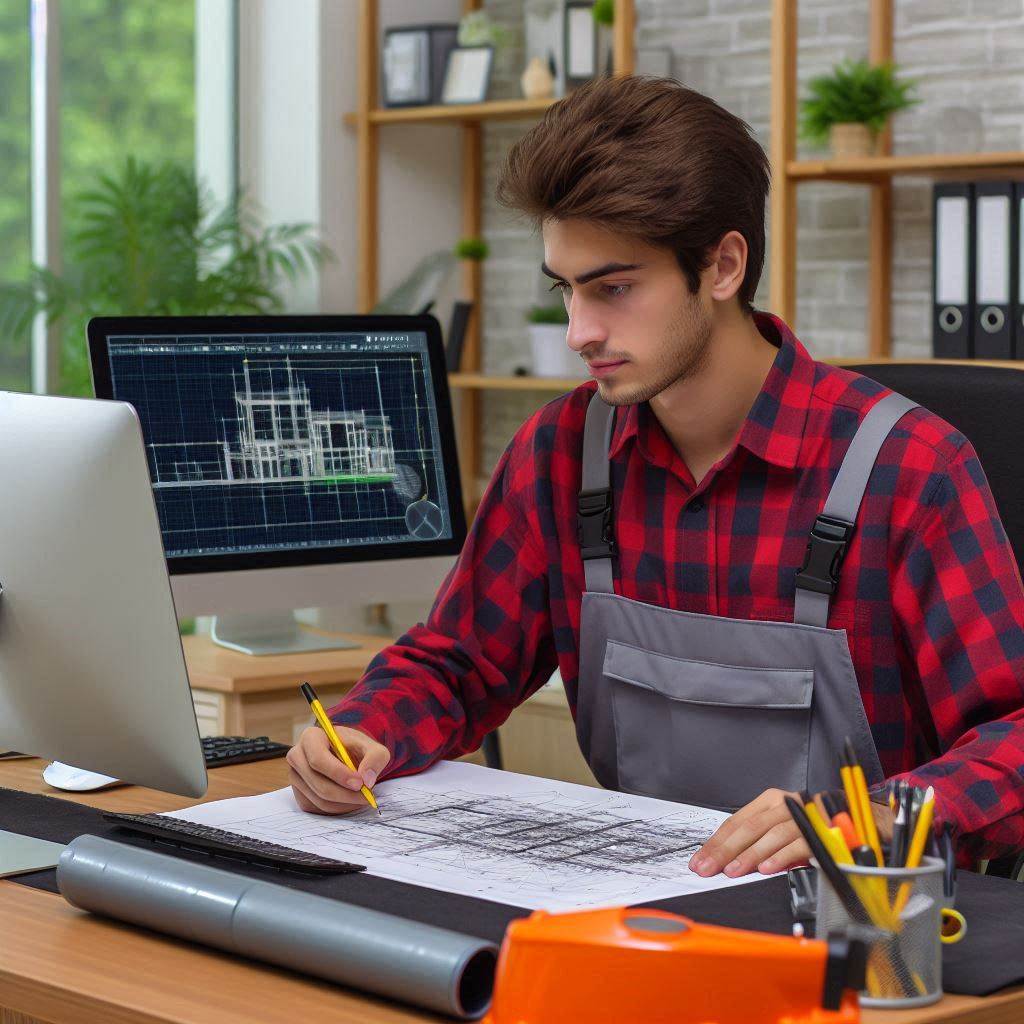Introduction
CAD Technicians play a crucial role in the modern workforce.
They create detailed drawings and plans for various projects.
These professionals use Computer-Aided Design (CAD) software to transform ideas into precise technical diagrams.
Their work spans across architecture, engineering, and manufacturing.
The demand for CAD Technicians is robust and growing.
Many industries rely on their expertise to develop and refine designs.
From constructing buildings to designing machinery, their skills are essential.
As technology evolves, the need for skilled CAD Technicians continues to rise.
Various sectors such as construction, automotive, and aerospace heavily depend on CAD Technicians.
In construction, they help in drafting blueprints and site layouts.
In automotive engineering, they design vehicle components and systems.
Aerospace industries use CAD for developing aircraft and spacecraft designs.
The versatility of their skills makes CAD Technicians valuable across multiple fields.
The job market for CAD Technicians is highly competitive.
As more professionals enter the field, standing out becomes increasingly important.
Employers look for candidates with not only technical skills but also relevant experience and certifications.
Networking and showcasing a strong portfolio can significantly enhance job prospects.
Research the Company
Importance of Researching the Company Before the Interview
Researching the company before your interview is crucial.
It shows genuine interest and preparation.
Understanding the company’s values, culture, and projects allows you to tailor your answers effectively.
This preparation can significantly increase your chances of success.
How to Gather Information About the Company’s Values, Culture, and Projects
Start by exploring the company’s website.
Review the “About Us” section to grasp their mission and values.
Look for recent news, press releases, and blog posts for updates on their current projects and future directions.
Check social media profiles, especially LinkedIn, to learn about team events and employee experiences.
Platforms like Glassdoor and Indeed provide insights from current and former employees, revealing the work environment and company culture.
Visit industry news websites and trade publications for additional details about the company’s latest projects and industry standing.
This helps you understand their role and current focus in the industry.
How to Tailor Your Answers to Align with the Company’s Goals and Values
Prepare to discuss how your skills align with the company’s current projects.
For instance, if they focus on sustainable building designs, highlight your experience with eco-friendly CAD solutions.
Relate specific projects from your past work to their initiatives.
Tailor your answers to reflect the company’s values.
If they emphasize innovation, discuss your creative solutions in previous projects.
Integrate details about their projects or culture into your responses to demonstrate your knowledge and enthusiasm.
Rehearse answers that incorporate this tailored information.
Practice discussing how your skills and experiences align with their needs.
This approach shows that you are well-prepared and genuinely interested in the role.
In summary, researching the company thoroughly before the interview is essential.
It helps you align your answers with their values and projects, showcasing your preparation and enthusiasm.
Demonstrating an understanding of their goals makes a compelling case for why you are the ideal CAD technician for their team.
Showcase Technical Skills
The Importance of Showcasing Technical Skills During the Interview
When interviewing for a CAD Technician position, showcasing your technical skills is crucial.
Employers want candidates who excel in using CAD software and have practical expertise.
Highlighting these skills helps prove you can contribute effectively to their projects.
Demonstrating your technical prowess ensures the interviewer recognizes your potential to deliver high-quality work.
Tips on How to Provide Examples of Past Projects and Experience
To stand out, prepare to discuss specific examples of your past projects.
Reflect on your work history and select projects that best showcase your technical skills.
Describe the challenges you faced and how you solved them using CAD tools.
For example, explain a complex design problem and your innovative solution.
Highlight your role, the software used, and any successful outcomes.
This approach not only shows your technical capabilities but also illustrates your problem-solving skills and creativity.
When detailing past projects, focus on your individual contributions.
Mention the software you used, any advanced features you applied, and how you integrated feedback.
This will provide a well-rounded view of your technical expertise and teamwork skills.
Including visual aids, such as images or diagrams from your portfolio, can further enhance your presentation.
The Need to Demonstrate Proficiency in CAD Software
Proficiency in CAD software is essential for a CAD Technician.
Be prepared to discuss the specific CAD programs you are skilled in.
Highlight experience with popular software such as AutoCAD, SolidWorks, or CATIA.
Mention any certifications or advanced training you have completed related to these tools.
Demonstrating familiarity with advanced features or customizations can set you apart.
When showcasing your CAD skills, focus on how you use software for detailed design tasks.
Discuss any scripting or automation skills you possess.
Providing examples of how you’ve utilized software’s advanced functionalities will emphasize your depth of knowledge and problem-solving abilities.
Additionally, be ready for practical tests or technical questions that may be part of the interview process.
In summary, effectively showcasing your technical skills during an interview involves highlighting your proficiency with CAD software.
Providing detailed examples of past projects, and demonstrating your problem-solving abilities.
This comprehensive approach ensures that you present yourself as a skilled and capable candidate for the CAD Technician role.
Prepare for Technical Questions
Technical questions in CAD Technician interviews often assess your knowledge of CAD software, problem-solving abilities, and design principles.
Understanding these questions will help you prepare effectively.
Types of Technical Questions
- Software Proficiency: Interviewers may ask about your experience with specific CAD software like AutoCAD, SolidWorks, or Revit. They want to gauge your familiarity with tools used in the industry.
- Design Challenges: Expect questions about solving design problems or creating specific elements. For instance, you might be asked to describe how you would design a part with particular constraints.
- Technical Processes: You may be questioned about your understanding of design processes, including drafting techniques, 3D modeling, and file management.
Sample Questions and Suggested Answers
Describe your experience with AutoCAD. What features do you use most frequently?
- Sample Answer: “I have used AutoCAD extensively for creating detailed 2D drawings. I frequently use layering, dimensioning, and annotation tools to ensure accuracy in my designs.”
How would you approach designing a complex component with tight tolerances?
- Sample Answer: “I would start by reviewing the specifications thoroughly. Then, I would use precise modeling techniques and regularly check dimensions to ensure compliance with the tolerances.”
Can you explain the difference between 2D and 3D CAD modeling?
- Sample Answer: “2D CAD modeling focuses on creating flat representations of objects, while 3D CAD modeling involves creating three-dimensional digital prototypes. 3D modeling allows for more detailed visualization and analysis.”
Tips for Practicing Technical Skills
- Review Software Tutorials: Spend time reviewing tutorials or documentation for the CAD software you use. Familiarize yourself with advanced features and shortcuts.
- Work on Practice Projects: Create mock projects or replicate existing designs to practice different aspects of CAD software. This helps reinforce your skills and uncover areas needing improvement.
- Participate in Online Forums: Join CAD-related forums or discussion groups. Engaging with peers can provide insights into common technical challenges and solutions.
- Use Simulation Software: Many CAD programs offer simulation tools. Practice using these tools to test your designs and understand how they perform under various conditions.
- Seek Feedback: Share your practice designs with colleagues or mentors for feedback. Constructive criticism can help you refine your techniques and better prepare for technical questions.
By preparing for these technical questions and practicing your skills, you can demonstrate your expertise and problem-solving abilities during the interview.
This preparation will help you stand out as a qualified CAD Technician candidate.
Read: Public Health and Environmental Engineering
Highlight Soft Skills
Soft skills are essential for CAD Technicians as they complement technical skills in the workplace.
Employers are looking for candidates who not only possess the necessary technical knowledge but also demonstrate various soft skills that are crucial for success in the field.
The importance of soft skills in addition to technical skills.
Soft skills play a significant role in the daily responsibilities of CAD Technicians.
They are essential for effective communication, problem-solving, teamwork, and overall job performance.
Employers value soft skills because they contribute to a positive work environment and enhance productivity.
Examples of Valuable Soft Skills for CAD Technicians
- Communication: CAD Technicians need to communicate effectively with team members, clients, and other stakeholders. Clear and concise communication helps prevent misunderstandings and ensures that projects are completed accurately and on time.
- Problem-Solving: CAD Technicians often encounter complex design challenges that require innovative solutions. Strong problem-solving skills enable them to identify issues, analyze them critically, and develop effective strategies to overcome obstacles.
- Teamwork: Collaboration is essential in the field of CAD. CAD Technicians must work closely with architects, engineers, and other professionals to bring projects to fruition. Strong teamwork skills involve the ability to share ideas, offer support, and coordinate efforts to achieve common goals.
Ways to demonstrate communication, problem-solving, and teamwork skills during the interview
During the interview process, candidates can showcase their soft skills by providing specific examples that highlight their abilities in communication, problem-solving, and teamwork. Here are some ways to demonstrate these important qualities:
- Communication: Practice active listening, maintain eye contact, and articulate your thoughts clearly. Provide examples of how you have effectively communicated with team members or clients in previous projects.
- Problem-Solving: Describe a challenging situation you encountered in a previous CAD project and explain how you approached the problem. Emphasize your analytical skills, creativity, and ability to think critically under pressure.
- Teamwork: Talk about your experience working in a team environment and highlight your contributions to group projects. Discuss how you collaborate with colleagues, resolve conflicts, and support the team to achieve common objectives.
By emphasizing your soft skills during the interview, you can differentiate yourself from other candidates and demonstrate that you have the well-rounded qualities necessary to succeed as a CAD Technician.
Remember to provide concrete examples that illustrate your capabilities and showcase your strengths in communication, problem-solving, and teamwork.
Read: How to Stay Updated in Environmental Engineering Field

Dress and Act Professionally
The Importance of Dressing Professionally for the Interview
When preparing for a CAD Technician interview, the importance of dressing professionally cannot be overstated.
Your attire plays a critical role in forming the first impression with your potential employer.
Dressing appropriately demonstrates your respect for the interview process and reflects your seriousness about the position.
Professional attire shows that you are committed and have taken the time to prepare, which can set a positive tone for the rest of the interview.
Even if the company has a more relaxed dress code, opting for business casual attire for the interview is a prudent choice.
It indicates that you understand the importance of making a good impression and are prepared to meet the company’s standards, regardless of their everyday dress code.
Tips on Appropriate Interview Attire for CAD Technician Positions
Choosing the right attire for a CAD Technician interview involves striking a balance between formal and casual.
For men, a collared shirt paired with dress pants and closed-toe shoes is ideal.
A blazer can add a touch of professionalism, but it is not always necessary.
Ensure that your clothing is well-fitted and free from wrinkles to convey neatness and attention to detail.
For women, a professional blouse or shirt with slacks or a knee-length skirt works well.
Closed-toe shoes are recommended to maintain a polished look.
Avoid overly casual items such as jeans, t-shirts, or sneakers, which may undermine your professionalism.
In addition to your clothing, pay attention to grooming.
Make sure your hair is neat, and avoid excessive accessories or strong fragrances.
Simple makeup and hairstyles are preferable, as they contribute to a clean, professional appearance without distracting from your qualifications.
The Significance of Body Language and Demeanor During the Interview
Body language and demeanor are critical elements of a successful interview.
Positive body language can significantly impact how you are perceived by the interviewer.
Begin by maintaining good posture; sit up straight and lean slightly forward to show engagement and interest in the conversation.
Avoid crossing your arms or slouching, as these can signal disinterest or lack of confidence.
Eye contact is essential; it demonstrates attentiveness and confidence.
A natural smile helps project friendliness and approachability, making you appear more personable and engaged.
A firm handshake at the beginning and end of the interview reinforces professionalism and leaves a lasting impression.
Additionally, be mindful of your tone and pace of speech.
Speak clearly and at a moderate pace to ensure that your responses are easily understood.
Avoid using filler words like “um” or “like,” as these can detract from your overall professionalism and clarity.
By paying attention to these aspects, you present yourself as a well-prepared, confident, and professional candidate, enhancing your chances of making a strong impression and securing the CAD Technician position.
Read: Environmental Engineering and Corporate Social Responsibility
Prepare Questions for the Interviewer
The Importance of Preparing Thoughtful Questions for the Interviewer
Preparing thoughtful questions for the interviewer is crucial.
It highlights your genuine interest in the role and the company.
Thoughtful questions demonstrate that you have done your research and are eager to learn more.
They also show that you are seriously considering how you fit within the company’s structure and goals.
Transform Your Career Today
Unlock a personalized career strategy that drives real results. Get tailored advice and a roadmap designed just for you.
Start NowSuggestions for Questions to Ask About the Company, Team, and Projects
When preparing questions, consider asking about the company’s culture and values.
Inquire how the company supports career development and growth opportunities.
This can give you insight into the company’s commitment to employee development.
Ask about the team dynamics and how they collaborate on projects.
Understanding the team’s working style can help you gauge how you might fit into the group.
It’s also valuable to ask about specific projects you would be involved in.
This shows your interest in the role and helps you understand the nature of your future responsibilities.
Additionally, inquire about the tools and software the company uses.
Knowing what technology you will work with helps you prepare and shows you are ready to contribute effectively.
Ask about the company’s future goals and how the CAD team aligns with these objectives.
This demonstrates your interest in the company’s direction and how you can be a part of it.
How Asking Questions Shows Interest and Engagement in the Potential Role
Asking thoughtful questions demonstrates your engagement and interest in the role.
It reflects your proactive attitude and desire to understand the company better.
By asking about the team, projects, and company goals, you show that you are not just interested in a job but in how you can contribute meaningfully.
Questions about the company’s culture, team dynamics, and future projects indicate that you are evaluating how well you align with the organization’s values and objectives.
This approach highlights your serious consideration of the role and your enthusiasm for contributing to the team’s success.
In summary, preparing insightful questions for the interviewer is a key strategy in showcasing your interest and engagement.
It helps you gather valuable information about the company, the team, and the projects, while also making a strong impression as a proactive and dedicated candidate.
Read: The Future of Environmental Engineering Jobs
Follow-Up After the Interview
The Importance of Sending a Thank You Note After the Interview
Sending a thank you note after your interview is a crucial step in the job application process.
This simple gesture demonstrates gratitude for the interviewer’s time and the opportunity to discuss the role.
It is also a chance to reinforce your enthusiasm for the position and the company.
A thank you note can differentiate you from other candidates and leave a lasting impression.
It shows that you value the interviewer’s time and are genuinely interested in the role, which can positively impact their perception of you.
A timely thank you note also helps keep you fresh in the interviewer’s mind.
By sending it within 24 hours, you ensure that your candidacy remains at the forefront of their thoughts.
This can be particularly important in competitive job markets where numerous candidates are vying for the same position.
The act of sending a thank you note reflects your professionalism and attention to detail, qualities that are highly valued in any candidate.
Tips on Crafting a Personalized Thank You Message
Crafting a personalized thank you message is key to making a strong impression.
Start your note by expressing your sincere gratitude for the opportunity to interview.
Thank the interviewer for their time and for considering you for the role.
Personalize your message by referencing specific topics or conversations from the interview.
This could include mentioning a particular project discussed or a point of shared interest.
Such details show that you were engaged and attentive during the interview.
Avoid using generic phrases that might come across as insincere.
Instead, tailor your message to reflect the unique aspects of your interview experience.
Highlight specific moments or insights that you found particularly valuable or enjoyable.
This not only demonstrates your interest but also reinforces your fit for the role.
Keep your thank you note concise and to the point.
A brief, focused message is more likely to be read and appreciated.
Maintain a professional tone throughout, and ensure that your note is free from grammatical or spelling errors.
A polished, well-written thank you note reflects your communication skills and attention to detail.
The Impact of Follow-Up Communication on the Hiring Decision
Follow-up communication can play a significant role in the hiring decision process.
A well-crafted thank you note can highlight your enthusiasm and commitment to the position.
It serves as an additional opportunity to reinforce your qualifications and address any points you may have overlooked during the interview.
This follow-up can positively influence the interviewer’s perception of you and set you apart from other candidates.
Hiring managers often appreciate candidates who take the initiative to follow up.
It reflects well on your professionalism and can demonstrate that you are proactive and organized.
Effective follow-up communication can leave a positive impression and reinforce your interest in the role.
It also shows that you are serious about the opportunity and respectful of the interviewer’s time.
Overall, follow-up communication, when done thoughtfully and professionally, can enhance your chances of securing the job.
It not only reinforces your suitability for the role but also highlights your commitment and attention to detail, which can be pivotal in the hiring decision.
Conclusion
In this blog post, we discussed essential interview tips for CAD Technician job seekers.
We explored how to prepare effectively, present your skills confidently, and address common interview questions.
Key points included researching the company, understanding the job requirements, and showcasing your technical expertise.
We also emphasized the importance of practicing common interview questions and demonstrating your problem-solving abilities.
To enhance your chances of success, apply these interview tips diligently.
Tailor your responses to highlight relevant experiences and skills.
Emphasize your proficiency with CAD software and your ability to manage projects efficiently.
Show enthusiasm for the role and the company, and be prepared to discuss how you can contribute to their success.
Finally, always remember to prepare thoroughly before your interview.
Review the job description and align your answers with the employer’s needs.
Practice answering questions out loud and seek feedback from peers or mentors.
Dress professionally and arrive early to demonstrate your punctuality and commitment.
Good luck with your interview preparations.
Implementing these tips will help you stand out and improve your chances of landing the CAD Technician job.




